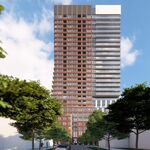dunkalunk
Senior Member
Here's what I envision in terms of a conceptual future rail network:

Only rail lines with passenger service are shown.
Red lines are built to HSR standards
Black are electrified conventional lines
Grey are unelectrified
I imagine following classes of service could exist once the infrastructure is there:
Super-Express (No-Stop Direct HSR to directly compete with airlines)
Toronto - Montreal (via South Ottawa Bypass)
Toronto - Ottawa - Montreal - Quebec
Toronto - Buffalo - New York
Toronto - Windsor/Detroit - Chicago
Express (Downtown to Downtown)
Toronto - Pearson 427 - Kitchener Central - London Central - Windsor/Detroit
Toronto - Hamilton North - Niagara Falls (Can/USA) - Buffalo
Toronto - Oshawa - Kingston - Ottawa - Dorval - Montreal Gare Centrale
Limited (Stops Only at Major GO Transfer Nodes)
Toronto - Bloor - Pearson 427 - Bramalea - Guelph - Hespeler 401 - Cambridge Delta
Toronto - Sunnyside - Long Branch(?) - Port Credit - Aldershot - Hamilton Central/Hamilton North
Toronto - Square One
etc..
Intercity (Serving Medium Sized Cities)
Toronto - Pearson 427 - Brampton - Georgetown - Guelph - Kitchener
London - Woodstock - Brantford - Hamilton North - St Catharines - Niagara Falls (CAN)
etc...
Regional (GO-Type stop spacing with DMU/EMUs)
London - Fanshawe - St Mary's - Stratford - Shakespeare - New Hamburg - Ira Needles - Kitchener
London - Gore - Dorchester - Ingersoll - Woodstock - Bonds Corners - Paris - Brantford - Lynden - Copetown - Dundas - Hamilton North
Ira Needles - Kitchener - Riverbend - Breslau - Imperial North - Guelph - Imperial South - Blackbridge - Hespeler 401 - Preston - Cambridge Delta
etc...
Local
What happens when you give the UPX subway-type spacing (no, I'm not calling it Smart Track, or surface subways)

Only rail lines with passenger service are shown.
Red lines are built to HSR standards
Black are electrified conventional lines
Grey are unelectrified
I imagine following classes of service could exist once the infrastructure is there:
Super-Express (No-Stop Direct HSR to directly compete with airlines)
Toronto - Montreal (via South Ottawa Bypass)
Toronto - Ottawa - Montreal - Quebec
Toronto - Buffalo - New York
Toronto - Windsor/Detroit - Chicago
Express (Downtown to Downtown)
Toronto - Pearson 427 - Kitchener Central - London Central - Windsor/Detroit
Toronto - Hamilton North - Niagara Falls (Can/USA) - Buffalo
Toronto - Oshawa - Kingston - Ottawa - Dorval - Montreal Gare Centrale
Limited (Stops Only at Major GO Transfer Nodes)
Toronto - Bloor - Pearson 427 - Bramalea - Guelph - Hespeler 401 - Cambridge Delta
Toronto - Sunnyside - Long Branch(?) - Port Credit - Aldershot - Hamilton Central/Hamilton North
Toronto - Square One
etc..
Intercity (Serving Medium Sized Cities)
Toronto - Pearson 427 - Brampton - Georgetown - Guelph - Kitchener
London - Woodstock - Brantford - Hamilton North - St Catharines - Niagara Falls (CAN)
etc...
Regional (GO-Type stop spacing with DMU/EMUs)
London - Fanshawe - St Mary's - Stratford - Shakespeare - New Hamburg - Ira Needles - Kitchener
London - Gore - Dorchester - Ingersoll - Woodstock - Bonds Corners - Paris - Brantford - Lynden - Copetown - Dundas - Hamilton North
Ira Needles - Kitchener - Riverbend - Breslau - Imperial North - Guelph - Imperial South - Blackbridge - Hespeler 401 - Preston - Cambridge Delta
etc...
Local
What happens when you give the UPX subway-type spacing (no, I'm not calling it Smart Track, or surface subways)
Last edited:





